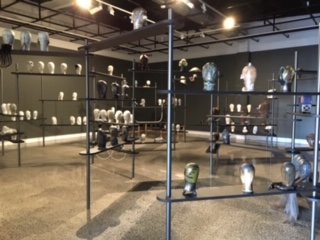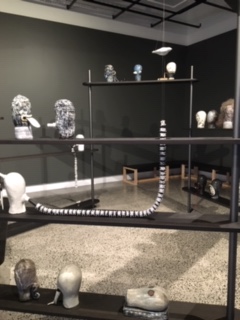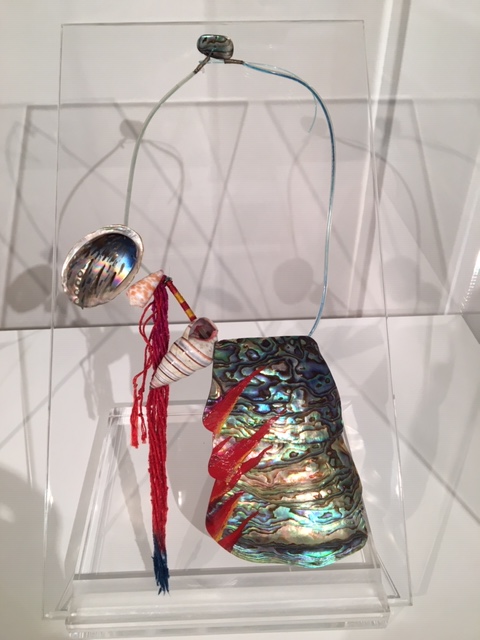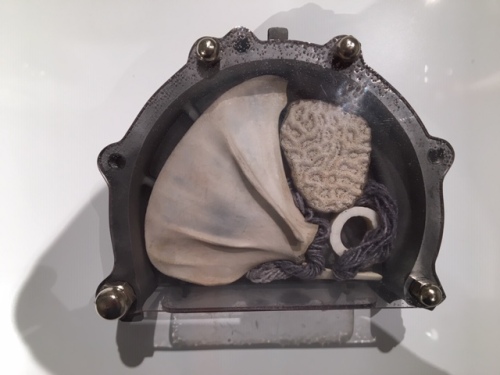Go to Objectspace where there are two interesting shows recently opened. In the main gallery is an exhibition by Julia Morrison, sent up from Christchurch Art Gallery. Morrison is from a fine arts background but has reportedly been working with clay for some eleven years. And it shows. The exhibition has a theoretical underpinning of signs and symbols based within somewhat esoteric knowledge systems such as the Jewish Kaballah, and other recondite frames of reference. I started to look up some of this but decided life is too short as the only thing I know about the Kaballah is that it was very popular with some Hollywood movie stars about a dozen years ago and was signified by wearing a particular bracelet. Unless you have the time to research, it’s maybe best just to experience the show.
This manifests as a series of open ‘rooms’ bounded by long shelves that hold many dozens of heads, abstracted from anything bodily. There is a palette largely restricted to shades of grey and brown – all very sombre. Single flashes of colour draw the eye swiftly. But it’s the repetition and variation that overwhelms all. It’s a marvellous lesson in pushing a single, simple form into so many variations, themes, adaptations, revisions, modifications and transfigurations as it’s pretty well possible to envision. It demonstrates how, given time, the imagination can continue to develop another angle on a given motif. Morrison has considered various aspects of the head, without and within and allowed other thoughts to bring forth something else – eyes, teeth, hair… While gestures made by heads as communication are also here. It is worth spending time with just to experience the different feelings this show creates in the viewing – wonder to revulsion, (does she know there’s a NYC singing group called roomful of teeth?) laughter to nausea. Why it’s in a gallery that exists for the exhibition of Craft, Design and Architecture and not ACAG is another topic. Ponder that but …. Go see.




While there do not miss the very fine survey, in the small gallery, of jewellery by…
ELENA GEE. Curated by Elle Louis there were talks at the opening event by Elle, Jeweller Lisa Walker and myself as an old friend of Elena’s. I have been asked by several to put my talk on this blog despite the subject not being ceramic. Here it is. Some images of her original and very fine jewellery follow.
I don’t recall exactly how or when I met Elena but it would be some time in the early to mid-eighties when we were both members of a craft community that was largely dominated by its male members and had been that way for some 20 or so years. This applied to her craft, that of jewellery, and my own – the ceramic tribal association.
Elena came from a family who were all makers and constructors of various sorts. From an early age she made dolls and multi-piece marionettes, then, following school, worked in a trade jewellers for a year or so while also selling her personal jewellery through the Bribiesca pottery stall in iconic Browns Mill. She was fired from that trade jewellery job for being too slow – signpost of things to come. In her early 20s, she left for Australia and stayed there for over ten years.
In Australia, Elena expected to need another job but soon found she could successfully support herself with her jewellery sales, again via a local potters shop. Her jewellery was noticed and she began to exhibit, initially tentatively, then regularly. She returned to NZ for flying visits to family and also to attend occasional short courses in jewellery making. By the time she returned to New Zealand permanently in ‘81 she was an established member of their craft community, her work had been taken into a number of major Australian institutional collections and included in touring shows. She had earned a considerable reputation for her inventive approaches to jewellery as body adornment.
Soon after her return, she was invited to join Fingers, by then very well established as a premier outlet for artist’s jewellery. She was cautious though, as regular rent contributions are part of the membership and she was unsure of her ability to meet her obligations but did so in 1988 after showing with them from 84.
Elena looked around for a group of women artists as she had enjoyed in Australia. She found our Women Artists Association and she and Beth Sarjeant enjoined me to go with them to the meetings in what was then Artstation at the end of Ponsonby Road. We were all ‘Westies’, Elena in Henderson, Beth in Green Bay and me up in Waiatarua and we were all of the ‘lesser arts’ – jewellery, printmaking and ceramics but the welcome and acceptance were as fulsome as for any painter or sculptor of fame and substance.
For me, it was a very new experience. At the Women Artists I heard great ideas and support for exhibitions of women’s work of the broadest genres and listened to debate around subjects I had no awareness of previously… and I recall, lively discussions around how five years should be maximum tenure for an Elam job, which, in those days, was high on the desirable list. Or why curators seemed to all be male–and who in turn chose male artists for some juicy off-shore exhibitions and residencies and more importantly – what might be done about this situation? Members ranged from working artists such as Claudia Pond Eyley, Carole Shepherd and Christine Hellyar to academics and leaders such as Pricilla Pitts, Merilyn Tweedie and Juliet Batten. I found them a formidable lot and felt my way cautiously, as ceramics of the time was pretty accepting of the dominant male patterning that prevailed. However, one thing I do vividly recall is Elena’s fearlessness in addressing such subjects. It was clear there was an intellect there very equal to any of the others. She spoke quietly and economically but her points were cogent and relevant, and she was listened to with respect. I learned much and gained pride and confidence in what we craftworkers might be able to achieve within a wider world of art.
Her own achievements were considerable. It was she who tackled Auckland Museums then curator of Applied Arts, Brian Muir, and suggested that as they collected ceramics they should also collect jewellery. She acquainted him with Fingers of which he knew not a lot and he forthwith visited and began to collect artist jewellery from the region. Two pieces of Elena’s were among the early works taken in and since then a further 16 works of hers have been added to that collection – mostly in the 80s and 90s as well as added to other public collections in other cities. Further, she was generous, my own career was increasingly taking me offshore for various events and Elena, most kindly, offered that I could borrow pieces of hers to wear at official functions. I never did but remain grateful for the offer.
It was Elena who was chosen to be the inaugural guest curator for the Dowse Art Museum’s biannual series of invitational survey shows around the current state of NZ artist jewellery. Hers was called ‘Open Heart’ and she chose first artists whose work she considered good rather than fit things to a curatorial premise. She was included in the next two Dowse instigated, touring, Biennales. And she was one of the featured artists in the internationally touring NZ jewellery exhibition, ‘Bone, Stone and Shell’ of 1988/9. This, Foreign Affairs supported show, went to Australia, and some major centres in Asia like Singapore and Tokyo. Other major shows included the Crafts Council of NZ’s swansong touring show Mau Mahara where very few contemporary artists were included and there was also the Dowse’s curated No Mans Land featuring many of NZs leading women artists who operated in 3D over a range of media… She showed in Shmuckzene in Munich and finally her work made the cover of the American Jewellery magazine, Ornament. These are but few of her considerable achievements.
But all the while, the slowness for which she was fired from that post-school employment back in the 60s gathered strength. Her energy levels, for a long time deteriorating, became more severely debilitated, and in 1990 she was diagnosed with Myalgic Encephalitis, M.E., Chronic Fatigue Syndrome or to put into Kiwi vernacular – Tapanui Flu after the south island town where it had some prevalence. Its cause and cure are still beyond reach.
Never one to give up easily, Elena continued to make jewellery and found ever simpler answers to the craftsperson’s ongoing encounter with challenges of making. She left incorporated materials in more natural states, interfering with elements as little as possible. She found surprising solutions to presenting her work in containers such as car engine parts – often elegantly topped with sliding perspex lids. She took more to casting some parts of her work so that completion was closer. Despite the apparent straightforwardness of manufacture, her pieces retained her own subjective language that transcended obvious connections between place and the corporeal.
She quite enjoyed the unpretentious simplicity of what she was making and continued working and exhibiting, as able, for another decade or so but by 2004 she was forced to say that she was now retired. Her energies too exhausted.
We are fortunate to have well-chosen representations of her work in some eight public and numerous private collections in Australia and New Zealand, a handful of good articles on her work in journals and catalogues and now, hopefully, an over-arching catalogue resulting from this survey that Elle has carried out, and I, personally, have some great memories of good conversations, inspirational home cooking and an important body of work. Don’t miss it.




Sadly I am two years too late to see this exhibition but just reading your review had me so intrigued I’ve spent the afternoon google imaging! I loved her subtle palette, the mix of glazed and unglazed and the slight creepiness of some of the heads. As a current diploma student at Otago Polytechnic, this exhibition would have corresponded well with our altering similar forms exercise.